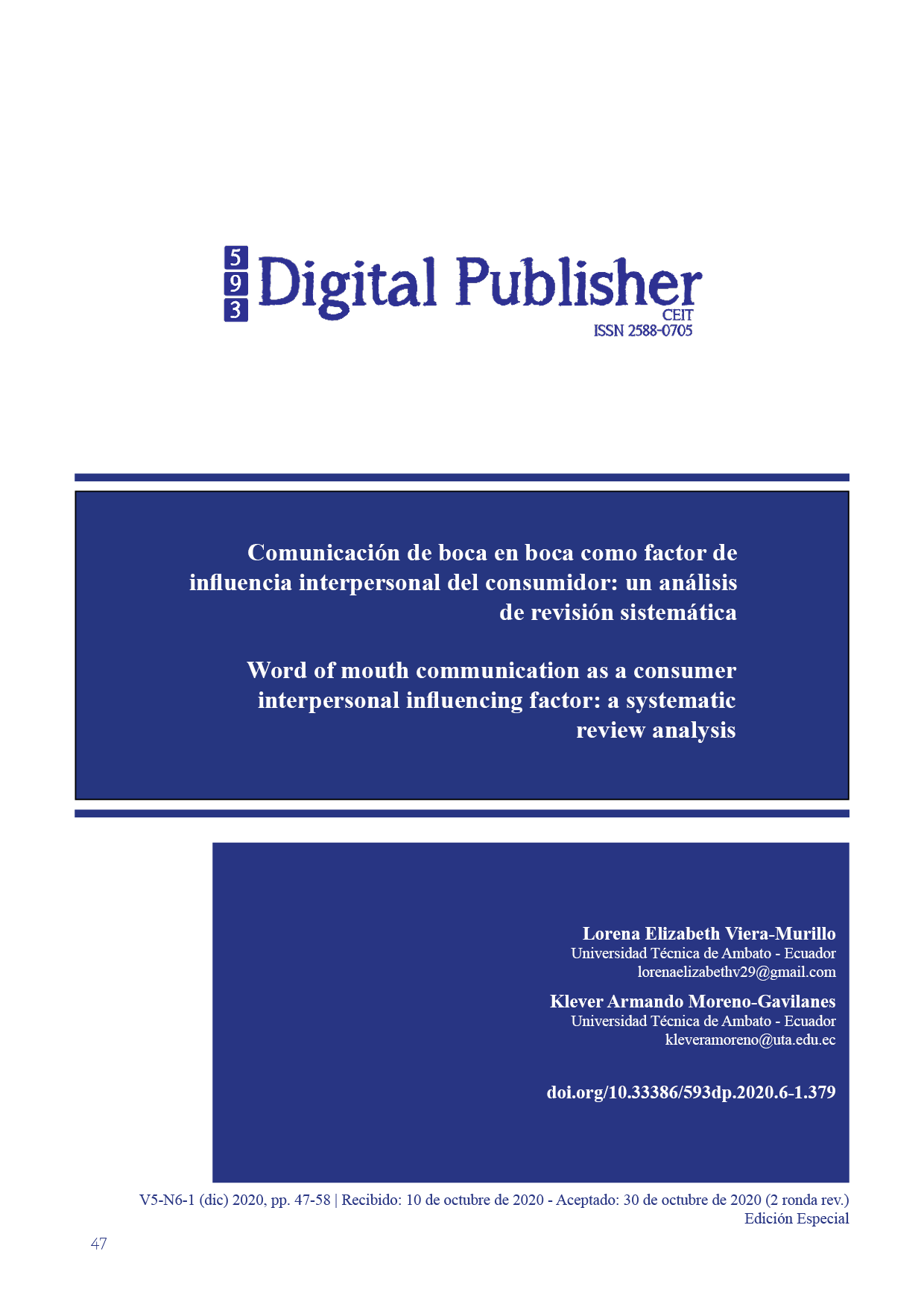Word of mouth communication as a consumer interpersonal influencing factor: a systematic review analysis
Main Article Content
Abstract
Technological advances in communication have not only joined the frontier but have also allowed consumers to share experiences of products or services they have acquired on virtual platforms, allowing the influence of purchase through interpersonal communication. The objective of the study is to determine the type of influence that the interactive advertising model exerts on word of mouth communication. The methodological design started from a systematic review and meta-analysis, it had a qualitative approach of a historical-hermeneutical nature, since it was specified, characterized, scrutinized and constituted of word of mouth communication as a factor of interpersonal influence of the consumer. The statistical method used was the Dersimonian and Laird 'test of heterogeneity. The main result is the heterogeneity that occurs in the dimensions of the model. It is concluded that the influence of IAM on word of mouth communication is positive, since the information shared about a product or service is reflected in the consumer's response.
Downloads
Article Details

This work is licensed under a Creative Commons Attribution-NonCommercial-ShareAlike 4.0 International License.
1. Derechos de autor
Las obras que se publican en 593 Digital Publisher CEIT están sujetas a los siguientes términos:
1.1. 593 Digital Publisher CEIT, conserva los derechos patrimoniales (copyright) de las obras publicadas, favorece y permite la reutilización de las mismas bajo la licencia Licencia Creative Commons 4.0 de Reconocimiento-NoComercial-CompartirIgual 4.0, por lo cual se pueden copiar, usar, difundir, transmitir y exponer públicamente, siempre que:
1.1.a. Se cite la autoría y fuente original de su publicación (revista, editorial, URL).
1.1.b. No se usen para fines comerciales u onerosos.
1.1.c. Se mencione la existencia y especificaciones de esta licencia de uso.
References
Álvarez, B., & Vázquez, R. (2005). Efectividad de la Promoción de Ventas. Análisis Comparativo para Diferentes Categorías de Productos. Revista de Economía y Empresa, 23(54), 11–28. http://www.epum2004.ua.es/aceptados/285.pdf
Arteaga, J., Coronel, V., & Acosta, M. (2018). Influencia del marketing digital en el desarrollo de las MIPYME’s en Ecuador. Espacios, 39, 47. http://www.revistaespacios.com/a18v39n47/a18v39n47p01.pdf
Asociación para la Investigación de Medios de Comunicación. (2015). AIMC. http://download.aimc.es/aimc/ROY76b/macro2015ppt.pdf
Balseiro, P. (2008). Como Multiplicar las Ventas a travez del boca en boca. 1–112.
Barbery Montoy, D. C., & Candell Dávila, E. F. (2018). Acciones del marketing para la promoción y creación de marca de artistas ecuatorianos. Academo Revista de Investigación En Ciencias Sociales y Humanidades, 6(1), 43–58. https://doi.org/10.30545/academo.2019.ene-jun.6
Barker, R. (2016). Confianza del consumidor. In SecEd (Issue 5). https://doi.org/10.12968/sece.2008.5.1179
Beele, P. (2010). Publicidad 2.0.
BIRKNEROVá, Z., BAČÍK, R., & GBUROVá, J. (2013). The Effectiveness of Advertising in Relation to the Personality of the Consumer. Journal of Finance and Economics, 1(2), 17–21. https://doi.org/10.12691/jfe-1-2-1
Blázquez, J. J., Molina, A., Talaya, E., & Navarro, M.-. (2008). ANÁLISIS DE LA EFICACIA PUBLICITARIA EN INTERNET. Investigaciones Europeas de Dirección y Economía de La Empresa, 1–19.
Carrasco, J. (2017). La influencia de los medios sociales digitales en el consumo. La función prescriptiva de los medios sociales en la decisión de compra de bebidas refrescantes en España. 1–293. https://eprints.ucm.es/42339/1/T38702.pdf
Carrillo, S., & Velezmoro, L. (2010). Tramas publicitarias de las Pymes del sector textil. Contratexto, 15.
Comunicación de mercadeo integral para las PyME del sector calzado, cuero y textil. (2009). Visión Gerencial, 230–242.
Connolly, P., & Chambers, C. (2010). Augmented Reality Effectiveness in Advertising. … Graphics Division, 193–202. https://doi.org/10.1109/ISMAR.2008.4637362
Corella, J. M. (1999). Introducción a la gestión de marketing en los servicios de Salud. In ANALES del Sistema Sanitario de Navarra. http://www.navarra.es/NR/rdonlyres/B31A650F-3952-4E42-A4C2-1439ED42F72D/147806/marketing1.pdf
Eisend, M., & Tarrahi, F. (2016). The Effectiveness of Advertising: A Meta-Meta-Analysis of Advertising Inputs and Outcomes. Journal of Advertising, 45(4), 519–531. https://doi.org/10.1080/00913367.2016.1185981
Eldridge, C. E. (1958). Advertising Effectiveness—How Can it be Measured? Journal of Marketing, 22(3), 241–251. https://doi.org/10.1177/002224295802200301
Elena, P. D. E. S. (2016). ÍNDICES DE VENTAS EN LOS CENTROS AUTOMOTRICES DE LA. 61–70.
Empresas, M., Sector, D. E. L., Geovani, E., González, F., Isela, F., & Cantú, H. (2013). Riaf-V6N3-2013-3. 6(3), 29–44.
Estévez, M., & Fabrizio, D. (2014). Advertising Effectiveness: An Approach Based on What Consumers Perceive and What Advertisers Need. Open Journal of Business and Management, 02(03), 180–188. https://doi.org/10.4236/ojbm.2014.23022
Fernández, E., Alameda, D., & Martin, I. (2011). Las estrategias publicitarias de las marcas en el contexto de crisis. 119–138.
Flandin, M. P., Martin, E., & Simkin, L. P. (1992). Advertising Effectiveness Research: A Survey of Agencies, Clients and Conflicts. International Journal of Advertising, 11(3), 203–214. https://doi.org/10.1080/02650487.1992.11104495
Frazer, C. F., Sheehan, K. B., & Patti, C. H. (2002). Advertising strategy and effective advertising: Comparing the USA and Australia. Journal of Marketing Communications, 8(3), 149–164. https://doi.org/10.1080/13527260210147324
Gamboa, J., Tovar, G., Armijo, G., & Hidalgo, H. (2018). Las estrategias comerciales para la captación de clientes del sector artesanal en el cantón Naranjito-Ecuador en el año 2017-2018. Polo Del Conocimiento, 3(6), 403. https://doi.org/10.23857/pc.v3i6.603
Garzón, J., Rodelo, J., Ocegueda, A., & Estrada, M. (2016). Estrategia Para Publicidad En Línea a Bajo Costo Para Las Pyme ’ S. Revista de Investigacion En Tecnologias de La Informacion, 3, 29–38.
Grado, T. D. F. De, & Cueco, S. C. (2015). Facultad De Ciencias Económicas Y Empresariales El Marketing " De Boca En Boca ".
Hoyos Zavala, A. E., & Lasso de la Vega González, C. (2017). Pymes como modelo económico en la creación de estrategias de comunicación. Retos, 7(13), 59. https://doi.org/10.17163/ret.n13.2017.04
Ibarra, W., Escalante, J., Ballesteros, L., & Guerrero, C. (2018). Redes Sociales Como Herramienta De Compromiso De Marca Del Sector Comercial. Revista de Investigación Enlace Universitario, 17(1), 56–64. https://doi.org/10.33789/enlace.17.41
Janischewski, C. (2007). Maximising advertising effectiveness. Newspaper Techniques, 3(MAY), 10–14.
Jaya, A., Iza, K., & Gavilema, O. (2018). ESTUDIO DE FACTORES QUE PROMUEVEN EL ÉXITO EN MIPYMES DEL CANTÓN GUARANDA, PROVINCIA DE BOLÍVAR S. Revista Científica ECOCIENCIA, 5(6), 1–20.
Jiménez, R. F. (2015). La publicidad, una estrategia de éxito para las micro, pequeñas y medianas empresas de la región centro y suroeste del Estado de Hidalgo. Inquietud Empresarial, 14(2), 133–152. https://doi.org/10.19053/01211048.3344
Kim, P. (1992). Does advertising work: A review of the evidence. Journal of Consumer Marketing, 9(4), 5–21. https://doi.org/10.1108/07363769210037042
López, O., Beltrán, C., Morales, R., & Cavero, O. (2018). Estrategias de marketing digital por medio de redes sociales en el contexto de las PYMES del Ecuador. Revista CienciAmérica, 7(2), 39. https://doi.org/10.33210/ca.v7i2.167
López Pérez, M. (2014). Marketing boca a boca. Cómo conseguir que el consumidor hable de tu producto marca. 215. https://digitum.um.es/xmlui/bitstream/10201/39206/1/Tesis Manuela López Pérez.pdf%0Ahttp://www.tdx.cat/handle/10803/144666
Marhuenda, C. M. (2016). La influencia del word of mouth electrónico sobre las ventas de un refresco. 289.
Martinez Freire, P. (2011). Concepciones cognitivas del ser humano. In La importancia del conocimiento. Filosofia y ciencias cognitivas (pp. 99–114). https://doi.org/10.4272/978-84-9745-172-7.ch6
Méndez-Rojas, M. A. (2016). Universidad de las Américas Puebla. Mundo Nano. Revista Interdisciplinaria En Nanociencia y Nanotecnología, 9(16), 106. https://doi.org/10.22201/ceiich.24485691e.2016.16.56905
Mendoza Pacheco, L. (2017). Publicidad digital y redes sociales dirigidas a jóvenes de la ciudad de Sucre. Abril, 1, 13. https://www.40defiebre.com/guia-seo/%0Aque-es-seo-por-que-necesito
Monge Martínez, E. (2015). La evolución de la estrategia en comunicación : Caso Coca-Cola. Comunicació.
Perdigón Llanes, R., Viltres Sala, H., & Madrigal Leiva, ivis rosa. (2018). Estrategias de comercio electrónico y marketing digital para pequeñas y medianas empresas E-commerce and digital marketing strategies for small and medium-sized enterprises. Revista Cubana de Ciencias Informáticas, 12(3), 17. http://rcci.uci.cu
Ramón Sarmiento Guede, J. (2015). La comunicación de “boca en boca” vs. la de “boca en boca electrónica”, análisis de sus principales diferencias. Ámbitos. Revista Internacional de Comunicación, 30. https://doi.org/10.12795/ambitos.2015.i30.04
Rose, E., & Godes, D. (2009). El boca en boca acerca de mercadotecnia de boca en boca. http://www.editorialpatria.com.mx/pdffiles/9786074388343.pdf
Sabharwal, D. (2016). Advertisements and its Effectiveness in Various Medias : A Theoretical Review. Aeronautical and Aerospace Engineering, 2(3), 475–478.
Sampieri, R., Fernandez, C., & Baptista, M. del P. (2014). Metodologia de la investigación (I. E. S.A. (Ed.); Sexta Edic). McGRAW-HIL.
Santillán, L., & Medrano, E. (2015). Las Redes Sociales una Alternativa al Marketing en las PYMES. Revista Publicando, 2(4), 12.
Singh, M., & Vikramjit, S. (2016). THE EFFECTIVENESS OF ONLINE ADVERTISING AND ITS IMPACT ON CONSUMER BUYING BEHAVIOUR. International Journal of Advanced Research in Management and Social Sciences, 5(5), 59–67.
Slusarczyk Antosz, M., & Morales Merchán, N. H. (2016). Análisis de las estrategias empresariales y de las TIC. 3C Empresa Investigación y Pensamiento Crítico, 05(01), 29–46. https://doi.org/10.17993/3cemp.2016.050125.29-46
Torres, E., & Garcia, S. (2014). La evolución de la estrategia publicitaria. Revista Mediterranea de Comunicacion, 5, 1–20.
Torres, R., Rivera, J., & Cabarcas, R. (2017). La efectividad del uso del marketing digital como estrategia para el posicionamiento de las pymes para el sector comercio en la ciudad de barranquilla. Revista UNISIMON-Investigación y Desarrollo En TICs, 8(2), 3–5. https://doi.org/https://doi.org/10.17081/invinno.3.1.2
Ueltschy, L. C., & Krampf, R. F. (2011). The Influence Of Acculturation On Advertising Effectiveness To The Hispanic Market. In Journal of Applied Business Research (JABR) (Vol. 13, Issue 2, p. 87). https://doi.org/10.19030/jabr.v13i2.5764
Universidad, ciencia y desarrollo. (2007). Fidelizar clientes, clave para que las pymes perduren. In reponame:Repositorio Institucional EdocUR.
Veas-González, I. A., Sanchez-Ortiz, A. D., & Perez-Cabañero, C. (2019). Determinantes del Marketing Boca a Boca en el Contexto Universitario: El Rol de la Satisfacción y la Lealtad de los Estudiantes. Formación Universitaria, 12(1), 45–54. https://doi.org/10.4067/s0718-50062019000100045
Vega, P. (2008). Estrategias Publicitarias enCosta Rica. II, 45–78.
Vera, A., Luna, A., & Ceballos, E. (2016). La imagen corporativa como ventaja competitiva en pequeñas empresas. Revista Iberoamericana de Ciencias, 114–125.
Zambrano, A. (2018). Marketing digital como estrategia para incrementar clientes. Revista Observatorio de La Economía Latinoamericana. http://www.eumed.net/cursecon/ecolat/ec/2018/clientes-empresa-promogaza.html
Zhang, Y., & Neelankavil, J. (1997). Advertising effectiveness in A cross-cultural study. European Journal of Marketing, 31, 135–149.



